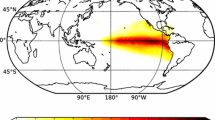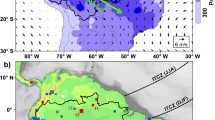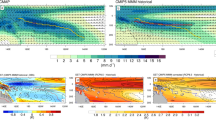Abstract
Most of CMIP5 models projected a weakened Walker circulation in tropical Pacific, but what causes such change is still an open question. By conducting idealized numerical simulations separating the effects of the spatially uniform sea surface temperature (SST) warming, extra land surface warming and differential SST warming, we demonstrate that the weakening of the Walker circulation is attributed to the western North Pacific (WNP) monsoon and South America land effects. The effect of the uniform SST warming is through so-called “richest-get-richer” mechanism. In response to a uniform surface warming, the WNP monsoon is enhanced by competing moisture with other large-scale convective branches. The strengthened WNP monsoon further induces surface westerlies in the equatorial western-central Pacific, weakening the Walker circulation. The increase of the greenhouse gases leads to a larger land surface warming than ocean surface. As a result, a greater thermal contrast occurs between American Continent and equatorial Pacific. The so-induced zonal pressure gradient anomaly forces low-level westerly anomalies over the equatorial eastern Pacific and weakens the Walker circulation. The differential SST warming also plays a role in driving low-level westerly anomalies over tropical Pacific. But such an effect involves a positive air-sea feedback that amplifies the weakening of both east–west SST gradient and Pacific trade winds.









Similar content being viewed by others
References
Bayr T, Dommenget D, Martin T, Power SB (2014) The eastward shift of the Walker circulation in response to global warming and its relationship to ENSO variability. Dyn Clim. doi:10.1007/s00382-014-2091-y
Bjerknes J (1969) Atmospheric teleconnections from the equatorial Pacific. Mon Wea Rev 97:163–172
Cane MA, Clement AC, Kaplan A, Kushnir Y, Pozdnyakov D, Seager R, Zebiak SE, Murtugudde R (1997) Twentieth-century sea surface temperature trends. Science 275:957–960
Chang CP, Li T (2000) A theory for the tropical tropospheric biennial oscillation. J Atmos Sci 57(14):2209–2224
Clement AC, Seager R, Cane MA, Zebiak SE (1996) An ocean dynamical. Thermostat J Clim 9:2190–2196
Collins M et al (2010) The impact of global warming on the tropical Pacific Ocean and El Nino. Nature Geosci 3:391–397
DiNezio P, Clement A, Vecchi GA, Soden B, Kirtman BP (2009) Climate response of the Equatorial Pacific to global warming. J Clim 22:4873–4892
DiNezio P, Clement A, Vecchi GA (2010) Reconciling differing views of tropical pacific climate change. EOS. 91(16):141–152
England MH, McGregor S, Spence P et al (2014) Recent intensification of wind-driven circulation in the Pacific and the ongoing warming hiatus. Nat Climate Change 4:222–227
Held IM, Soden BJ (2006) Robust responses of the hydrological cycle to global warming. J Clim 19:5686–5699
Hoskins BJ, Karoly DJ (1981) The steady linear response of a spherical atmosphere to thermal and orographic forcing. J Atmos Sci 38(6):1179–1196
Hsu P-C, Li T (2012) Is “rich-get-richer” valid for Indian ocean and Atlantic ITCZ? Geophys Res Lett 39:L13705. doi:10.1029/2012GL052399
IPCC (2007) Climate change 2007: the physical science basis. In: Solomon S et al (eds) Contribution of working group I to the fourth assessment report of the intergovernmental panel on climate change. Cambridge University Press, Cambridge and New York, p 996
Knutson TR, Manabe S (1995) Time-mean response over the tropical Pacific to increased CO2 in a coupled ocean-atmosphere model. J Clim 8:2181–2199
Knutson TR, Manabe S et al (2010) Tropical cyclones and climate change. Nat Geosci 3(3):157–163
Li T, Kwon M, Zhao M, Kug J, Luo J, Yu W (2010) Global warming shifts Pacific tropical cyclone location. Geophys Res Lett 37:L2I404. doi:10.1029/2010GL045124
Li T, Zhang L, Murakami H (2015) Strengthening of the Walker circulation under global warming in an aqua-planet general circulation model simulation. Atmos. Sci Adv. doi:10.1007/s00376-015-5033-7
Luo JJ, Sasaki W, Masumoto Y (2012) Indian Ocean warming modulates Pacific climate change. Proc Natl Acad Sci 109:18701–18706
Manabe S, Bryan K, Spelman MJ (1990) Transient response of a global ocean-atmosphere model to a doubling of atmospheric carbon dioxide. J Phys Oceanogr 20(5):722–749
Manabe S, Stouffer RJ, Spelman MJ, Bryan K (1991) Transient responses of a coupled ocean-atmosphere model to gradual changes of atmospheric CO2. Part I. Annual mean response. J Clim 4(8):785–818
McGregor S, Timmermann A, Stuecker MF et al (2014) Recent Walker circulation strengthening and Pacific cooling amplified by Atlantic warming. Nat Clim Chang 4:888–892
Murakami H, Wang B, Kitoh A (2011) Future change of western North Pacific typhoons: projections by a 20-km-mesh global atmospheric model. J Clim 24:1154–1169
Murakami H, Wang B, Kitoh A, Mizuta R, Shindo E (2012) Future changes in tropical cyclone activity projected by multi-physics and multi-SST ensemble experiments using the 60-km-mesh MRI-AGCM. Clim Dyn 39(9–10):2569–2584
Roeckner E et al (1996) The atmospheric general circulation model ECHAM-4: model description and simulation of present-day climate. Max Planck Institute Rep. 218:90
Sandeep S, Stordal F, Sardeshmukh PD, Compo GP (2014) Pacific Walker circulation variability in coupled and uncoupled climate models. Clim Dyn 43(1–2):103–117
Schneider T, O`Gorman PA, Levine XJ (2010) Water vapor and the dynamics of climate changes. Rev Geophys 48:302–323
Trenberth KE, Fasullo JT, Branstator G, Phillips AS (2014) Seasonal aspects of the recent pause in surface warming. Nat Climate Change. doi:10.1038/NCLIMATE2341
Vecchi GA, Soden BJ (2007) Global warming and the weakening of the tropical circulation. J Clim 20:4316–4340
Vecchi GA, Soden BJ, Wittenberg AT, Held IM, Leetmaa A, Harrison MJ (2006) Weakening of tropical Pacific atmospheric circulation due to anthropogenic forcing. Nature 441:73–76
Vecchi GA, Clement A, Soden BJ (2008) Examining the Tropical Pacific’s response to global warming. EOS 89:81–83
Wallace JM, Gutzler DS (1981) Teleconnections in the geopotential height field during the Northern Hemisphere winter. Mon Weather Rev 109(4):784–812
Wang B, Wu R, Fu X (2000) Pacific-East Asian teleconnection: how does ENSO affect East Asian climate. J Clim 13:1517–1536
Wang B, Xiang B, Lee JY (2013) Subtropical high predictability establishes a promising way for monsoon and tropical storm predictions. Proc Natl Acad Sci 110(8):2718–2722
Xie SP, Deser C, Vecchi GA, Ma J, Teng H, Wittenberg AT (2010) Global warming pattern formation: sea surface temperature and rainfall. J Clim 23:966–986
Zhang L (2016) The roles of external forcing and natural variability in global warming hiatuses. Clim Dyn. doi:10.1007/s00382-016-3018-6
Zhang L, Li T (2014) A simple analytical model for understanding the formation of sea surface temperature patterns under global warming. J Climate 27(22):8413–8421
Zhao M, Held IM (2010) An analysis of the effect of global warming on the intensity of Atlantic Hurricanes using a GCM with statistical refinement. J Climate 23:6382–6393
Zhao M, Held IM (2012) TC-permitting GCM simulations of Hurricane frequency response to sea surface temperature anomalies projected for the Late 21st century. J Climate 25:2995–3009
Acknowledgments
This work was supported by China National 973 project 2015CB453200, NRL grant N00173-13-1-G902, ONR grant N00014-16-12260 and the International Pacific Research Center that is sponsored by the Japan Agency for Marine-Earth Science and Technology (JAMSTEC). All the datasets from CMIP5 models can be accessed through ESGF data portals (http://pcmdi-cmip.llnl.gov/cmip5/availability.html). This is SOEST contribution number 9611, IPRC contribution number 1185, and ESMC contribution number 101.
Author information
Authors and Affiliations
Corresponding author
Rights and permissions
About this article
Cite this article
Zhang, L., Li, T. Relative roles of differential SST warming, uniform SST warming and land surface warming in determining the Walker circulation changes under global warming. Clim Dyn 48, 987–997 (2017). https://doi.org/10.1007/s00382-016-3123-6
Received:
Accepted:
Published:
Issue Date:
DOI: https://doi.org/10.1007/s00382-016-3123-6




